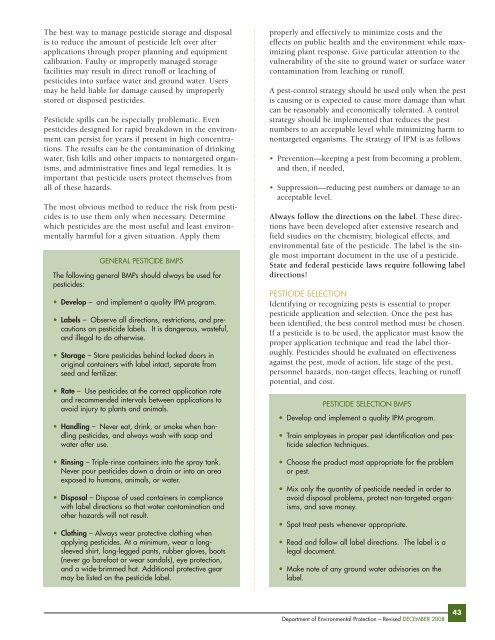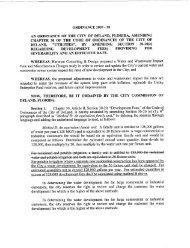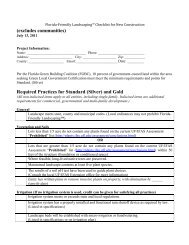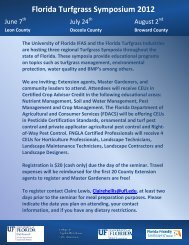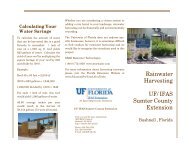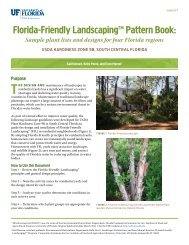ladybird beetles, green lacewings, and mantids) may bepurchased and released near pest infestations. However,the landscape can also be modified to attract natural enemies,provide habitat for them, and protect them frompesticide applications. For example, flowering plants mayprovide parasitoids with nectar, or sucking insects(aphids, mealybugs, or soft scales) may provide a honeydewsource when growing on less-valuable plants.The genetic component relies on the breeding or geneticengineering of turfgrasses and landscape plants that areresistant to key pests. Such resistance could increase aplant’s tolerance to damage and weaken or kill the pests.Pests may also develop more slowly on partially resistantplants, thereby increasing their susceptibility to naturalenemies or “softer” pesticides. Selecting resistant cultivarsor plant species when designing a landscape is a veryimportant part of IPM. Although turfgrass and landscapemanagers often work with established plant material, theycan still recommend changes. Every opportunity shouldbe taken to educate builders, developers, landscape architects,sod producers, and others on which plants are bestsuited to their areas.Chemical controls include a wide assortment of conventional,broad-spectrum pesticides and more selective,newer chemicals, such as microbial insecticides andinsect growth regulators. IPM is not antipesticide, but itdoes promote the use of the least-toxic and most selectivealternatives when chemicals are necessary. Pesticides areonly one weapon against pests and should be usedresponsibly and in combination with other, less-toxiccontrol tactics.To determine which pesticides are most appropriate foruse, and when and how to use them, consult the appropriatepesticide selection guides produced by IFAS.Whenever practical, limit treatment to infected areas.Spot spraying lessens pesticide use, saving the applicationservice money and lowering risk to beneficial organisms,pets, homeowners, and the environment. Consult withcounty Cooperative Extension Service agents, chemicaldistributors, product manufacturers, or independent turfor landscape maintenance consultants.IPM is commonly used in agricultural crop production,where the economic thresholds for key pests have beendetermined. Using IPM in the urban environment, however,has been more challenging. The <strong>Green</strong> Industry issensitive to aesthetic damage, and customers are oftenintolerant of anything that could affect the appearance ofornamental plants. Increased education of growers, consumers,and maintenance personnel could raise the aestheticthreshold and allow for minor damage withoutcompromising plant health and beauty.Another important aspect of a successful IPM programis pest monitoring. This includes understanding the lifecycle of a pest and knowing which plants and conditionsit may prefer. Monitoring populations, understandinghistorical trends, and knowing where a pest is mostlikely to occur can target control practices to a specificpest in a specific location. Maintaining records and historiesof pest populations can help a manager forecastpest occurrence and apply pesticides wisely.The monitoring of pest populations presents specialdifficulties for the service industry, because the serviceprofessional may only be on-site one day per month orless. While spot applications are generally preferable, incertain situations preventative measures may be necessary.This is particularly true where experience hasdetermined that less pesticide, or a less toxic pesticide,may be needed when a preventative control is used.The basic steps for IPM programs are as follows:• Identify key pests on key plants.• Determine the pest’s life cycle, and know which lifestage to target (for an insect pest, whether it is anegg, larva/nymph, pupa, or adult).• Use cultural, mechanical, or physical methods toprevent problems from occurring (for example,prepare the site, select resistant cultivars), reducepest habitat (for example, practice good sanitation,carry out pruning and dethatching), or promotebiological control (for example, provide nectar orhoneydew sources).• Decide which pest management practice is appropriateand carry out corrective actions. Direct controlwhere the pest lives or feeds. Use preventative chemicalapplications only when your professional judgmentindicates that properly timed preventative applicationsare likely to control the target pest effectivelywhile minimizing the economic and environmentalcosts.• Determine if the “corrective actions” actually reducedor prevented pest populations, were economical, andminimized risks. Record and use this informationwhen making similar decisions in the future.For more information on IPM, see IFAS PublicationENY-336, Integrated Pest <strong>Management</strong> in the CommercialOrnamental Nursery, at http://edis.ifas.ufl.edu/IG144.PESTICIDE USEPesticides are designed to kill or alter the behavior ofpests. When, where, and how they can be used safelyand effectively is a matter of considerable public interest.If they are not used wisely, pesticides may poserisks to pesticide applicators and other exposed people,and may create long-term environmental problems.42FLORIDA FRIENDLY BEST MANAGEMENT PRACTICES for Protection of Water Resources by the <strong>Green</strong> <strong>Industries</strong>
The best way to manage pesticide storage and disposalis to reduce the amount of pesticide left over afterapplications through proper planning and equipmentcalibration. Faulty or improperly managed storagefacilities may result in direct runoff or leaching ofpesticides into surface water and ground water. Usersmay be held liable for damage caused by improperlystored or disposed pesticides.Pesticide spills can be especially problematic. Evenpesticides designed for rapid breakdown in the environmentcan persist for years if present in high concentrations.The results can be the contamination of drinkingwater, fish kills and other impacts to nontargeted organisms,and administrative fines and legal remedies. It isimportant that pesticide users protect themselves fromall of these hazards.The most obvious method to reduce the risk from pesticidesis to use them only when necessary. Determinewhich pesticides are the most useful and least environmentallyharmful for a given situation. Apply themGENERAL PESTICIDE BMPSThe following general BMPs should always be used forpesticides:• Develop – and implement a quality IPM program.• Labels – Observe all directions, restrictions, and precautionson pesticide labels. It is dangerous, wasteful,and illegal to do otherwise.• Storage – Store pesticides behind locked doors inoriginal containers with label intact, separate fromseed and fertilizer.• Rate – Use pesticides at the correct application rateand recommended intervals between applications toavoid injury to plants and animals.• Handling – Never eat, drink, or smoke when handlingpesticides, and always wash with soap andwater after use.• Rinsing – Triple-rinse containers into the spray tank.Never pour pesticides down a drain or into an areaexposed to humans, animals, or water.• Disposal – Dispose of used containers in compliancewith label directions so that water contamination andother hazards will not result.• Clothing – Always wear protective clothing whenapplying pesticides. At a minimum, wear a longsleevedshirt, long-legged pants, rubber gloves, boots(never go barefoot or wear sandals), eye protection,and a wide-brimmed hat. Additional protective gearmay be listed on the pesticide label.properly and effectively to minimize costs and theeffects on public health and the environment while maximizingplant response. Give particular attention to thevulnerability of the site to ground water or surface watercontamination from leaching or runoff.A pest-control strategy should be used only when the pestis causing or is expected to cause more damage than whatcan be reasonably and economically tolerated. A controlstrategy should be implemented that reduces the pestnumbers to an acceptable level while minimizing harm tonontargeted organisms. The strategy of IPM is as follows• Prevention—keeping a pest from becoming a problem,and then, if needed,• Suppression—reducing pest numbers or damage to anacceptable level.Always follow the directions on the label. These directionshave been developed after extensive research andfield studies on the chemistry, biological effects, andenvironmental fate of the pesticide. The label is the singlemost important document in the use of a pesticide.State and federal pesticide laws require following labeldirections!PESTICIDE SELECTIONIdentifying or recognizing pests is essential to properpesticide application and selection. Once the pest hasbeen identified, the best control method must be chosen.If a pesticide is to be used, the applicator must know theproper application technique and read the label thoroughly.Pesticides should be evaluated on effectivenessagainst the pest, mode of action, life stage of the pest,personnel hazards, non-target effects, leaching or runoffpotential, and cost.PESTICIDE SELECTION BMPS• Develop and implement a quality IPM program.• Train employees in proper pest identification and pesticideselection techniques.• Choose the product most appropriate for the problemor pest.• Mix only the quantity of pesticide needed in order toavoid disposal problems, protect non-targeted organisms,and save money.• Spot treat pests whenever appropriate.• Read and follow all label directions. The label is alegal document.• Make note of any ground water advisories on thelabel.Department of Environmental Protection – Revised DECEMBER 200843
- Page 3 and 4: GOALS OF THE MANUALThis manual prov
- Page 5 and 6: Table of ContentsGOALS OF THE MANUA
- Page 7 and 8: Chapter 1: IntroductionUSING BEST M
- Page 9 and 10: these is performed properly, the ne
- Page 11: BMPs, job safety, and the specific
- Page 14 and 15: compacted by construction activity?
- Page 16 and 17: promotes deeper rooting, which is o
- Page 18 and 19: Protection, water management distri
- Page 21 and 22: IRRIGATION SYSTEM INSTALLATIONOnly
- Page 23 and 24: tion promotes deeper root developme
- Page 25 and 26: GREEN INDUSTRY IRRIGATION BMPSThe p
- Page 27 and 28: MOWING THE FLORIDA LAWNMowing is an
- Page 29 and 30: MANGROVESThree species of mangroves
- Page 31 and 32: Chapter 5: FertilizationFERTILIZER
- Page 33 and 34: cases, these stabilized N materials
- Page 35 and 36: influences the activity of the soil
- Page 37 and 38: nitrogen restrictions discussed ear
- Page 39 and 40: impervious surface that drains to a
- Page 41 and 42: The P content of the fertilizer sho
- Page 43 and 44: plastic container, mix them thoroug
- Page 45 and 46: think that less fertilization is al
- Page 47: help to establish proof of proper u
- Page 51 and 52: Segregate herbicides, insecticides,
- Page 53 and 54: pressure, size of nozzle, and spaci
- Page 55 and 56: MANAGEMENT OF PESTS IN THE LANDSCAP
- Page 57 and 58: ReferencesUnless otherwise mentione
- Page 59 and 60: Pruning Shade Trees in the Landscap
- Page 61 and 62: APPENDIX A: IMPORTANT TELEPHONE NUM
- Page 63 and 64: APPENDIX B: FLORIDA COOPERATIVE EXT
- Page 65 and 66: APPENDIX C: RULE 5E-1.003(2) LABELI
- Page 67 and 68: EMERGENCY REPORTING TELEPHONE NUMBE


